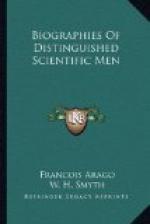Bodies unequally heated act upon each other even at great distances, even through empty space, for the colder becomes more hot, and the hotter becomes more cold; for after a certain time they indicate the same degree of the thermometer, whatever may have been the difference of their original temperatures. According to the hypotheses above explained, there is but one way of conceiving this action at a distance; this is to suppose that it operates by the aid of certain effluvia which traverse space by passing from the hot body to the cold body; that is, to admit that a hot body emits in every direction rays of heat, as luminous bodies emit rays of light.
The effluvia, the radiating emanations by the aid of which two distant bodies form a calorific communication with each other, have been very appropriately designated by the name of radiating caloric.
Whatever may be said to the contrary, radiating heat had already been the object of important experiments before Fourier undertook his labours. The celebrated academicians of the Cimento found, nearly two centuries ago, that this heat is reflected like light; that, as in the case of light, a concave mirror concentrates it at the focus. Upon substituting balls of snow for heated bodies, they even went so far as to prove that frigorific foci may be formed by way of reflection. Some years afterwards Mariotte, a member of this Academy, discovered that there exist different kinds of radiating heat; that the heat with which rays of light are accompanied traverses all transparent media as easily as light does; while, again, the caloric which emanates from a strongly heated, but opaque substance, while the rays of heat, which are found mingled with the luminous rays of a body moderately incandescent, are almost entirely arrested in their passage through the most transparent plate of glass!
This striking discovery, let us remark in passing, will show, notwithstanding the ridicule of pretended savans, how happily inspired were the workmen in founderies, who looked at the incandescent matter of their furnaces, only through a plate of ordinary glass, thinking by the aid of this artifice to arrest the heat which would have burned their eyes.
In the experimental sciences, the epochs of the most brilliant progress are almost always separated by long intervals of almost absolute repose. Thus, after Mariotte, there elapsed more than a century without history having to record any new property of radiating heat. Then, in close succession, we find in the solar light obscure calorific rays, the existence of which could admit of being established only with the thermometer, and which may be completely separated from luminous rays by the aid of the prism; we discover, by the aid of terrestrial bodies, that the emission of caloric rays, and consequently the cooling of those bodies, is considerably retarded by the polish of the surfaces; that the colour, the nature, and the thickness




